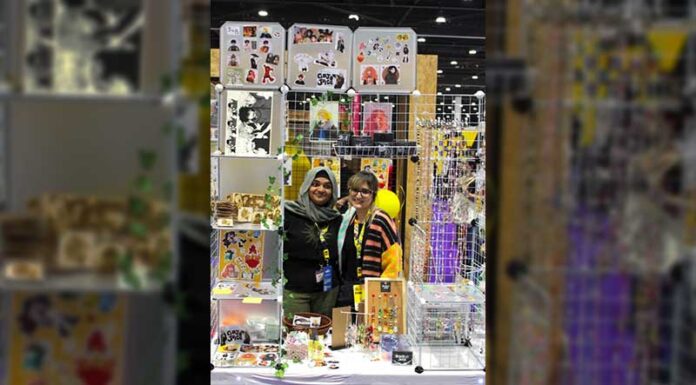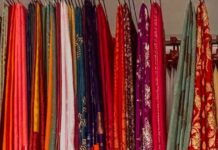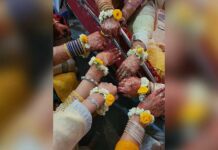By Dina Helmy
Rahma Zuhair is a young freelance self-taught artist and illustrator. She started her art journey when she was 14. She is an information systems and business analytics major at the American University of Sharjah and is the president of the Startup SBA organization. Zuhair was also a presenter at Comic-con International 2024.
1. You recently presented at Comic-con International, can you share your experience and thoughts about how it helped you as an illustrator?
I heard that Comic-con was a really good place to check if people would respond to your art through a different media. However, being a university student, I did procrastinate a little bit with the prep for Comic-con 2024. I ended up making everything that I sold in the last week. So far I’ve been a purely digital artist but when it comes to the prints, there are so many things involved. I wanted to learn how to make stickers and print on wood, ceramics and acrylics, so I took a membership at SoiLAB and I learned how to 3D print in one week. But I’d say more than the exposure, more than the kind of people you meet and the kind of interactions you have with people who like your art at Comic-con, what really made my experience a whole lot meaningful was definitely the week before where, because I procrastinated and I didn’t have time to send all my art out for printing, I was forced to learn all of it on my own.
2. Why do you believe it is necessary to get out of your comfort zone and seize opportunities?
As an artist, I feel like digital art itself is not very out there. With visual media, it is more of a behind-the-scenes thing where you are stuck a little bit in your comfort zone and I feel like taking that step from just being a creator to then going into selling your art and turning it into a business is where getting out of your comfort zone comes into play, at least for me. I think it’s extremely important because when people start with art it’s always from a place of “it brings me comfort, it’s a hobby.” But when you want to start taking it seriously at some point you’re gonna have to put your foot down and be like, okay, now’s the point where I have to start making less fun things.
3. What was the most challenging part of your art journey?
The change in mindset from becoming like a creator to a business-minded person was very difficult for me initially because when you’re drawing and when you’re creating art for yourself, it’s different. When you’re creating art and putting it on the internet, it’s different. And then when you’re creating art to sell, it’s completely different. I think I was in that stage when I was trying to grow my account, which is when I switched to selling it. So then it obviously no longer became what gets more likes, it became what sells more. It’s very hard to keep your love for what you’re doing when that happens. But I think I’ve been able to navigate it a little while.
4. I noticed you have mentioned on your profile that you are focused on creating art rather than generating content. Can you explain what that means to you?
I feel like intentions and your goals for what you create matter because people can go around saying I’m just doing this for fun. But the second it starts getting a little bit more serious, the second you start getting a bit more orders, a bit more followers and you start not dreaming, but kind of seeing this going somewhere and you start believing. Oh wow, this might take off. Then there’s so much pressure on yourself. Art has always been about expressing myself and the second that changed; it wasn’t a very good experience. So yeah, definitely make art, not content. And if people like your art, great, because content you’re making for other people, but the art you’re making for yourself.
5. What is a moment you believe altered your perception and helped you grow as an artist?
I started murals a few months ago. So during the middle of 2023, I did my first wall painting and it was traditional. I think that was a very defining moment in my journey because so far, until 2023, I was purely a digital artist, and in 2023, I got a commission to do two walls at the Radisson Red Lobby by hand. To be fair, I hadn’t drawn traditionally, or professionally in like ever. I had to learn everything from scratch again. This first experience gave me the confidence to believe that I’m doing it for the first time, but also the stakes are so high. So I have no option but to get it right. So yeah, I think that’s definitely a moment that gave me the confidence that I needed.
6. How did it feel to turn your digital art into actual products?
Honestly, the first day of Comic-Con was my first time selling my art. The first person who comes and buys my things told me she’s been following my art for a year or so and she came all the way to buy my Percy Jackson stickers. I was over the moon cause this had never happened to me before. From digital to traditional, it makes it way more real. Like when people are walking by and they see some character that they like or a sticker sheet that they like, and then they start freaking out to their friends.
7. If you could go back in time, what is one thing you would encourage your younger self to do?
When I was younger, I would just not keep any of my art because I started doing it because I used to think a lot. I had a really big issue with overthinking and I used to always scratch something with a pencil when I used to overthink. And then it just gradually turned into drawings and I would just not think and do sketches. So I’d probably encourage myself to keep those sketches because I don’t know, I never considered my art good or never considered myself an artist in a way where I’d keep myself. I’d just always throw it away. But yeah, I’d probably say keep your art so you can see how you grow.
8. What kind of advice would you give to similar young artists who are just starting?
It’s less inspirational, and more technical advice. I feel like if you’re just starting, if you’ve just sat through at least one tutorial or one YouTube video it would help. The second thing I’d say is references. Using references has made my anatomy and has made my structure so much better. Using references is not cheating; it’s just a way of learning.
9. What are your future plans regarding making your artwork tangible?
I am doing a few murals at AUS’s student center. I’m very excited about it because they’ve given me 10 walls. The fact that I get to leave behind a legacy at AUS is absolutely insane. Another thing I’m looking into is World Art Dubai. They’ve invited me to do a few live drawings there. Another thing that I’m looking into is teaching. There’s this company that’s starting workshops for kids and for digital art and murals and pottery and ceramics and stuff, so I’m registering as an instructor.
10. What is something you believe will help you massively in this journey?
I guess it goes back to my overthinking problem. This whole “it doesn’t hurt to try” mentality really helps. Even though I have that mentality, I do have a lot of self-doubt so maybe work on it a little bit. That’ll definitely help. Just getting a bit more confident with my own things would definitely help.
11. How do you feel about collaborating with other artists or brands to help put your artwork out there?
That’s definitely something I’d be interested in because I do have a lot of ideas for things like that. I feel like I need to work a little bit more on my socials and get a bigger reach for things like that. I still haven’t explored my art on clothing. I have gotten a few requests to do denim jackets and shoes and stuff. So yeah, definitely.
Her art can be found here: https://www.instagram.com/rahmaybe/


















